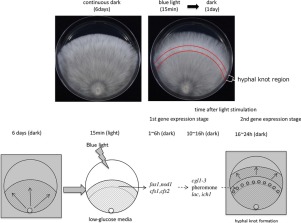Microbiological Research ( IF 6.7 ) Pub Date : 2018-09-08 , DOI: 10.1016/j.micres.2018.09.003 Yuichi Sakamoto , Shiho Sato , Miyuki Ito , Yuki Ando , Kiyoshi Nakahori , Hajime Muraguchi

|
Light and nutrients are crucial environmental factors influencing fungal sexual reproduction. Blue light induces simultaneous hyphal knot formation in Coprinopsis cinerea mycelia grown on low-glucose media but not in mycelia grown on high-glucose media. Many hyphal knots are visible in the arc near the edge of the colony one day after 15 min of blue light stimulation. These findings collectively suggest that blue light accelerates hyphal knot induction in nutrient-limited conditions. Transcriptome analysis revealed that gene expression after light exposure is divided into at least two major stages. In the first stage, genes coding for fasciclin (fas1), cyclopropane-fatty-acyl-phospholipid synthases (cfs1 and cfs2), and putative lipid exporter (nod1) are highly expressed after 1 h of light exposure in the mycelial region where the hyphal knot will be developed. These genes are upregulated by blue light and not influenced by glucose condition and mating. These results suggest that although some of the genes are critical for induction of the hyphal knots, they are not sufficient for hyphal knot development. In the second gene expression stage, genes encoding galectins (cgl1-3), farnesyl cysteine-carboxyl methyltransferases, mating pheromone-containing protein, nucleus protein (ich1), and laccase (lcc1) are specifically upregulated at 10–16 h after blue light exposure when the mycelia are cultivated on low-glucose media. These genes might be involved in the architecture of hyphal knots or signal transduction for further fruiting body development. These results contribute to the understanding of the effect of environmental factors on sexual reproduction in basidiomycetous fungi
中文翻译:

蓝光照射和养分条件影响灰糖鸡腿菌同时菌丝结形成相关基因的表达
光和营养是影响真菌有性繁殖的关键环境因素。蓝光诱导在低葡萄糖培养基上生长的灰粉菌的菌丝体中同时形成菌丝结,但在高葡萄糖培养基上生长的菌丝体中却不诱导菌丝结形成。蓝光刺激15分钟后的一天,在菌落边缘附近的弧中可见许多菌丝结。这些发现共同表明,在营养有限的条件下,蓝光会加速菌丝结的诱导。转录组分析表明,光照后的基因表达至少分为两个主要阶段。在第一阶段,编码fasciclin(fas1),环丙烷-脂肪-酰基-磷脂合成酶(cfs1和cfs2)的基因),并且假定的脂质输出物(nod1)在光照后1 h在菌丝结形成的菌丝体区域中高表达。这些基因被蓝光上调,不受葡萄糖条件和交配的影响。这些结果表明,尽管某些基因对于诱导菌丝结至关重要,但它们不足以促进菌丝结的发育。在第二个基因表达阶段,编码半乳糖凝集素(cgl1-3),法呢基半胱氨酸-羧基甲基转移酶,交配信息素的蛋白,核蛋白(ich1)和漆酶(lcc1)的基因当在低葡萄糖培养基上培养菌丝体时,特别是在蓝光照射后10–16 h上调。这些基因可能参与菌丝结的构建或信号转导,以进一步促进子实体的发育。这些结果有助于了解环境因素对担子菌真菌有性繁殖的影响。



























 京公网安备 11010802027423号
京公网安备 11010802027423号